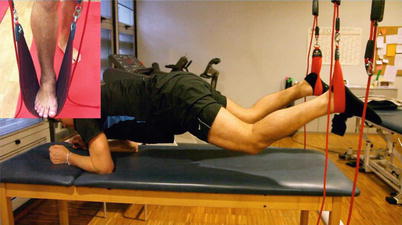Fig. 54.1
Muscles and bones are subjected to less tension into water. It allows greater control of local edema, better mobilization, and greater muscle strengthening with a lower risk of functional overload
The posture is controlled by allowing an activity that involves an erect position and with proper coordination: the therapist can notice that the movement is not performed along the predetermined line, while the patient realizes how this movement is not monitored [17, 18].
During rehabilitation, water must have a temperature near 32 °C (89.6 °F). The flow of water, ropes, elastic bands, shovels, sticks, floats, weights, and even fins are the useful aids.
It should be noted that the density of water does not allow the speed increment; thereby, it is difficult to perform lactic acid muscle works that affect the anaerobic process. In this way the training activity involves a lower number of inflammations.
This type of rehabilitation is useful not only in the initial phase but also in the intermediate and final stages of the rehabilitation process for edema control.
54.8 NEURAC Rehabilitation
At the earliest stages of rehabilitation, we make use of a method called NEURAC (neuromuscular reactivation) that is carried out with a suspension system made by cables and ropes (defined as Redcord). This phase begins during unloading but can continue even after the giving of weight bearing. Such cables are applied in different points so that it is possible to create vectors of translation or rotation, as well as compression and decoaptation.
The peculiarity of this method is that it takes place in a closed kinetic chain emphasizing the role of the stabilizing musculature (type I fibers) and training the sensorimotor system.
It consists of the following:
1.
Periarticular sensory afferents from bone, capsule, ligaments, tendons, and muscles
2.
Interpretation of this information by the central nervous system and development of an efferent motor program
3.
Periarticular muscles expressing the motor program prepared by the nervous system
After surgical treatment the sensorimotor system can be inefficient for several reasons: compensation previously established due to the pain, lack of peripheral afferents, lack of central ability to develop efficient motor programs, and insufficient periarticular muscle strength. Pain and injuries clearly accelerate, in a negative direction, the progression of these factors. Indeed, pain inhibits efficiency of the sensorimotor system. Any source of pain can interfere with the sensorimotor system producing a constant vicious circle “pain-sensorimotor deficit-pain.” Therefore, it is important to reprogram the sensorimotor patterns of the whole fascial and muscular system, taking into account that the trunk and the pelvis (especially the transversus abdominis muscle, the quadratus lumborum, and the gluteus medius) are a very important key for the stability of the lower limbs and then the stability of the ankle (Fig. 54.2).


Fig. 54.2
NEURAC – record system. Is possible to improve patient’s strength and functional capacity (coordination and balance)
They are useful exercises for all ages and improve patient’s strength and functional capacity (coordination and balance). You can activate different muscle groups during a single exercise which is recommended for about 10 min 3 times week in relation to the patient’s age.
54.9 Computerized Proprioception
This phase of training takes place after the giving of weight bearing.
Early mobilization promotes not only tissue nourishment but also a good orientation of the cicatricial fibers for capsular elasticity, and, subsequently, it allows to preserve a good muscle tone and tropism and maintain afferent and efferent neuromotor activities with a great advantage in the pursuit of the final goal, that is, the functional recovery.
The recovery of motor patterns and coordination is crucial, because only the reconquest of proprioceptive ability will allow a return to the sport. Afferent proprioceptive inputs are conveyed to different levels of the central nervous system [19], but most remain unconscious and only a very few (approximately one signal out of a million) are able to reach the conscious level [20]. The joint position sense and the joint movement sense (kinesthesia) are the expression of the conscious component, while postural control and joint stability are mainly based on the unconscious component [19]. In the case of the antigravity movements, proprioceptive control is the expression of the effectiveness of stabilizing reflexes in controlling vertical stability [21]. By antigravity movements, we mean activities which require the individual to counteract gravity and postural instability with at least a phase of single-limb stance (walking, running, jumping, going up and down stairs, and so forth). Proprioceptive inputs are the most important sensory system in the maintenance of static postural stability at all ages.
Coupling single-stance stability with high-frequency instability of an electronic rocking board is able to reprogram proprioceptive control [22]. High-frequency instability is induced by the visual trace on the monitor (a feedback of the rocking movements of the board acting as feedforward) which tracks the subject and notably increases the number of corrections of the platform position. On the same rocking board, without visual tracking, you would experience instability only at low frequencies. The visual feedforward enhances the frequency of instability of the rocking base refining the postural reactions. In this way the postural adaptations can change from macroamplitude at low frequency to microamplitude at high frequency [22]. Besides the subcortical tracking, the visual information permits to assign specific tasks as trying to maintain the moving plate at an inclination corresponding to a certain level of supination or pronation (4–12° of supination, 4–8° of pronation) or passing from an inclination to another. These exercises of dynamic exploration are very effective to improve ankle functional stability and single-stance stability.
Stay updated, free articles. Join our Telegram channel

Full access? Get Clinical Tree






